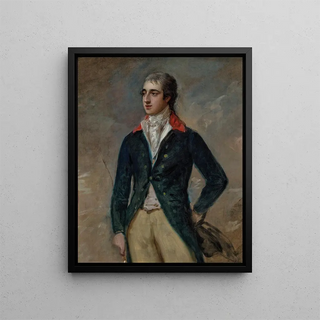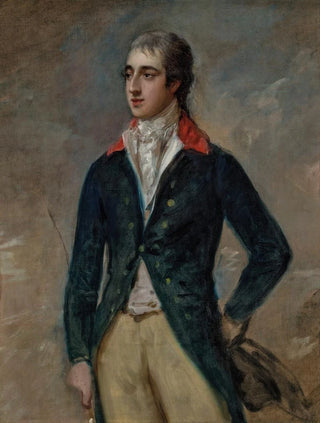Art print | Portrait of Prince Ernest Augustus 1771-1851 later King of Hanover - Thomas Gainsborough


View from behind

Frame (optional)
In the rich and captivating universe of 18th-century English painting, the work of Thomas Gainsborough stands out for its elegance and psychological depth. The "Portrait of Prince Ernest-Augustus 1771-1851, later King of Hanover" is an emblematic example of this artistic mastery. This painting, which captures both the nobility and complexity of the subject, immerses us in an era where art reflected the morals and aspirations of a society in full transformation. Through this art print, we have the opportunity to rediscover not only the portrait of a man but also a bygone era, where the portrait served as a link between the individual and their social status.
Style and uniqueness of the artwork
Gainsborough's style is often characterized by a sensitive and intuitive approach to color and light. In this portrait, the delicate treatment of drapery and the play of shadows and highlights reveal technical virtuosity that transcends simple representation. The prince, carefully dressed, is highlighted by a blurred background that emphasizes his majestic presence. The details of his face, imbued with gentle melancholy, reflect a complex personality, while the finesse of the brushstrokes demonstrates meticulous attention to every aspect of the composition. Gainsborough manages to capture the very essence of his subject, transforming the portrait into a true window into the prince's soul.
The artist and his influence
Thomas Gainsborough, a major figure of the Rococo movement, knew how to blend tradition and innovation. His influence on subsequent generations of artists is undeniable, not only through his innovative approach to portraiture but also through his ability to humanize his subjects. By moving away from the rigid conventions of official portraiture of the time, Gainsborough paved the way for a more intimate and personal representation. His style inspired artists such as John Constable and Joshua Reynolds, who both sought to explore emotions and psychology through their works. The way Gainsborough integrated nature into his portraits, using landscapes in the background, also left a lasting mark on British art.
A wall decoration

Matte finish

View from behind

Frame (optional)
In the rich and captivating universe of 18th-century English painting, the work of Thomas Gainsborough stands out for its elegance and psychological depth. The "Portrait of Prince Ernest-Augustus 1771-1851, later King of Hanover" is an emblematic example of this artistic mastery. This painting, which captures both the nobility and complexity of the subject, immerses us in an era where art reflected the morals and aspirations of a society in full transformation. Through this art print, we have the opportunity to rediscover not only the portrait of a man but also a bygone era, where the portrait served as a link between the individual and their social status.
Style and uniqueness of the artwork
Gainsborough's style is often characterized by a sensitive and intuitive approach to color and light. In this portrait, the delicate treatment of drapery and the play of shadows and highlights reveal technical virtuosity that transcends simple representation. The prince, carefully dressed, is highlighted by a blurred background that emphasizes his majestic presence. The details of his face, imbued with gentle melancholy, reflect a complex personality, while the finesse of the brushstrokes demonstrates meticulous attention to every aspect of the composition. Gainsborough manages to capture the very essence of his subject, transforming the portrait into a true window into the prince's soul.
The artist and his influence
Thomas Gainsborough, a major figure of the Rococo movement, knew how to blend tradition and innovation. His influence on subsequent generations of artists is undeniable, not only through his innovative approach to portraiture but also through his ability to humanize his subjects. By moving away from the rigid conventions of official portraiture of the time, Gainsborough paved the way for a more intimate and personal representation. His style inspired artists such as John Constable and Joshua Reynolds, who both sought to explore emotions and psychology through their works. The way Gainsborough integrated nature into his portraits, using landscapes in the background, also left a lasting mark on British art.
A wall decoration






